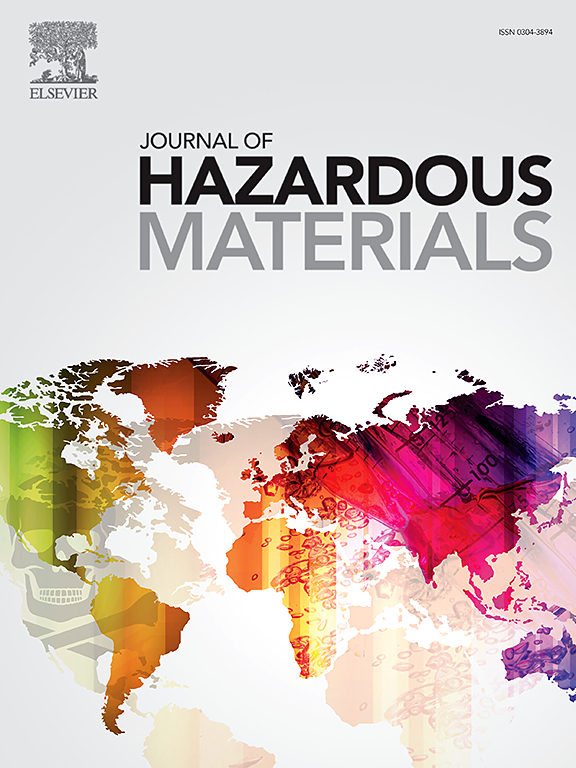IF 12.2
1区 环境科学与生态学
Q1 ENGINEERING, ENVIRONMENTAL
引用次数: 0
摘要
在高盐度条件下,将氯离子(Cl-)转化为活性氯物种(RCS)是将铵(NH4⁺-N)选择性氧化为氮(N2)的有效策略。因此,在模拟再循环海水养殖系统(RMS)水处理中引入了真空紫外线(VUV)辐照去除 NH4⁺-N。VUV/UV/Cl- 工艺实现了 NH4⁺-N 的完全氧化和 88.3% 的 N2 选择性。机理分析表明,在紫外光照射下,Cl- 被有效地转化为 RCS,而氯氧化自由基(ClO-)是去除 NH4+-N 的主要 RCS。由于氯胺是主要的中间产物,因此 NH4+-N 氧化的途径被认为是氯化。影响因素调查表明,在紫外/紫外/氯化过程中,Cl- 和碳酸氢盐(HCO3-)会加速 ClO-的生成,从而显著促进 NH4+-N 的去除。最后,还研究了实际应用中 VUV/UV/Cl- 工艺去除 NH4+-N 的性能。结果表明,VUV/UV/Cl- 工艺不仅能有效地将实际海水或 RMS 中的 NH4+-N 转化为 N2,还能有效地去除亚硝酸盐(NO2--N)和部分硝酸盐(NO3--N)。因此,VUV/UV/Cl- 工艺在 RMS 水处理中去除 NH4+-N 和总氮(TN)方面具有广阔的前景。本文章由计算机程序翻译,如有差异,请以英文原文为准。

Selective oxidation of ammonium to nitrogen with VUV/UV/Cl⁻ process: efficiency, pathway and mechanism
Conversion of chloride ions (Cl⁻) into reactive chlorine species (RCS) is an effective strategy for ammonium (NH4⁺-N) selective oxidation to nitrogen (N2) under high salinity conditions. Herein, vacuum ultraviolet (VUV) irradiation was introduced for NH4⁺-N removal in simulated recirculating mariculture systems (RMS) water treatment. Complete oxidation of NH4⁺-N and 88.3% N2 selectivity were achieved for VUV/UV/Cl⁻ process. Mechanism analysis revealed that Cl⁻ were effectively converted into RCS under VUV irradiation and chlorine oxide radical (ClO•) was the predominant RCS responsible for NH4+-N removal. The pathway of NH4+-N oxidation was proposed as chlorination because chloramine was identified as the main intermediate. Influence factor investigation indicated that Cl⁻ and bicarbonate (HCO3⁻) could significantly promote the removal of NH4+-N in VUV/UV/Cl⁻ process due to acceleration of ClO• generation. Ultimately, the NH4+-N removal performance of VUV/UV/Cl⁻ process in practical application was also investigated. The results showed that not only NH4+-N in actual seawater or RMS could be converted effectively to N2, but also nitrite (NO2⁻-N) and partial nitrate (NO3⁻-N) could be removed efficiently by VUV/UV/Cl⁻ process. Hence, the VUV/UV/Cl⁻ process has promising potential in NH4+-N and total nitrogen (TN) removal for RMS water treatment.
求助全文
通过发布文献求助,成功后即可免费获取论文全文。
去求助
来源期刊

Journal of Hazardous Materials
工程技术-工程:环境
CiteScore
25.40
自引率
5.90%
发文量
3059
审稿时长
58 days
期刊介绍:
The Journal of Hazardous Materials serves as a global platform for promoting cutting-edge research in the field of Environmental Science and Engineering. Our publication features a wide range of articles, including full-length research papers, review articles, and perspectives, with the aim of enhancing our understanding of the dangers and risks associated with various materials concerning public health and the environment. It is important to note that the term "environmental contaminants" refers specifically to substances that pose hazardous effects through contamination, while excluding those that do not have such impacts on the environment or human health. Moreover, we emphasize the distinction between wastes and hazardous materials in order to provide further clarity on the scope of the journal. We have a keen interest in exploring specific compounds and microbial agents that have adverse effects on the environment.
 求助内容:
求助内容: 应助结果提醒方式:
应助结果提醒方式:


